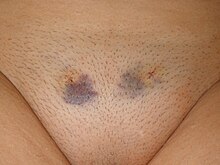Tension-free vaginal tape
Tension free vaginal tape (TVT for short) describes a plastic tape made of polypropylene ( Prolene ) and an associated surgical procedure in urogynecology for the treatment of a certain form of urinary incontinence , the so-called stress incontinence (outdated: stress incontinence).
indication
There are several risk factors for female urinary incontinence. In particular, the condition of the (stretched) pelvic floor after several births, congenital connective tissue weakness and obesity (overweight) must be taken into account . As a result, it may e.g. B. when coughing, laughing, sneezing or climbing stairs lead to incontinence, the so-called stress incontinence (outdated: stress incontinence). The activities mentioned, as well as being overweight, result in an intra-abdominal pressure increase (i.e. in the abdominal cavity), which acts on the urinary bladder from above. A healthy pelvic floor offers the underside of the urinary bladder and the urethra a counter bearing so that a locking mechanism is guaranteed. If the pelvic floor is weakened, this counter bearing cannot withstand the increased bladder pressure: the locking mechanism is overcome and you lose urine. In mild cases, the person affected can heal through daily exercises to train the pelvic floor muscles . In more severe cases, but especially when the patient is under great strain, surgical therapy comes into play.
background
The TVT plastic (tension free vaginal tape) according to Ulmsten represents a gentler surgical technique for the treatment of stress urinary incontinence compared to classic surgical therapy. It has been carried out in the Scandinavian countries since 1995 and in Germany since June 1996. It has now established itself in many other European countries and the United States.
execution
With this technique, under general anesthesia (sometimes also spinal anesthesia ), a plastic band is placed tension-free under the urethra and carried out through small incisions behind the pubic bone (os pubis) up through the cavum rezii.
During the intraoperative cough test, the loop is raised just enough that there is no more loss of urine when coughing. A frequent complication here is an overcorrection of the incontinence, which can lead to postoperative urination disorders. An individual adjustment of the position of the tape to the respective length of the urethra is inevitable, as the tape can only function fully if it is optimally positioned.
A preoperative pelvic floor sonography, but above all the measurement of the urethral length, is indicated in every case.
The mode of action of the DVT plastic consists in the tension-free stabilization of the middle urethra and indirectly the base of the bladder. In this way, the connective tissue and ligament defect is compensated because the urethra (and thus incontinence) is prevented from sinking under pressure.
Complications
Possible complications of DVT surgery can include:
- Continued incontinence
- Bladder emptying disorders with overcorrection (band that is too tight)
- "Tethered Tape" - The tape has grown together with the skin of the vagina, which disrupts the function of the tape
- Ligament erosion - the ligament has migrated through the vaginal wall and is exposed. Not only is the tape inoperative, it can also lead to infections
- The general complications of surgery
Web links
Individual evidence
- ↑ J. Kociszewski, V. square: Stress incontinence - Individually treat thanks to optimal diagnosis. Retrieved October 4, 2019 .
